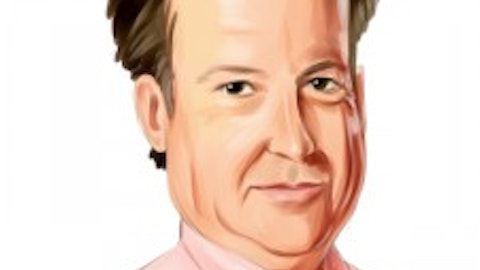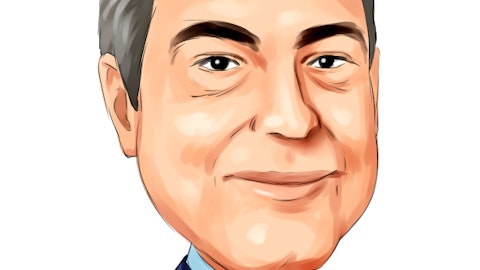New York-based Long Cast Advisers LLC, a boutique investment management firm, published its first-quarter 2021 investor letter – a copy of which can be downloaded here. Cumulative returns on accounts managed by Long Cast Advisers improved 30%, net of applicable fees, ahead of the baseline (S&P Total Return index, iShares MicroCap ETF and the Russell 2000 index). You can view the fund’s top 5 holdings to have a peek at their top bets for 2021.
Long Cast Advisers, in its Q1 2021 investor letter, mentioned S&W Seed Company (NASDAQ: SANW), and shared their insights on the company. S&W Seed Company is a Longmont, Colorado-based proprietary seed company that currently has a $131.8 million market capitalization. Since the beginning of the year, SANW delivered a 22.53% return, extending its 12-month gains to 56.09%. As of May 28, 2021, the stock closed at $3.56 per share.
Here is what Long Cast Advisers has to say about S&W Seed Company in its Q1 2021 investor letter:
“You likely notice we’ve been purchasing S & W Seed (SANW), a producer and manufacturer of agricultural seeds. At current price of $3.90 and with 34M diluted shares and $50M in debt, SANW has an enterprise value of ~$180M. Against trailing 12-month sales, this infers a 2x EV / sales multiple which is in the mid point of the 1x-3x range typically seen in the industry space.
My interest in the company was piqued b/c I was looking for something that would work as a potential commodity hedge against inflation, and agriculture tends to do that. Digging in, I saw two broad attributes that make this company compelling.
First, agriculture unfolds over a time frame that is utterly foreign to Wall Street – 6 to 8 year development cycles, limited by growing seasons – and that makes the company largely uninvestable to anybody but the most patient investor. It’s perfect for us! Second, the company is coming towards the end of a product development cycle with three new products to be released in the next 24 months. These will be the first new product launches since the company altered its strategy about six years ago.
By way of backstory, back in 2015, SANW was pretty close to a pure play on alfalfa seeds and Saudi Arabia was its second largest market. Then, in the midst of a drought, the Saudi monarchy decided to no longer grow domestic alfalfa.
The company had a large shareholder, noted small cap value investor Michael Price, who owned a ~10% stake in the company and he brought on the Board Mark Wong, an agriculture industry veteran who had previously built, grown and sold companies in the industry and in his retirement, ran his own ag business “for fun”. The company was already in the process of a slow pivot to diversifying its products and end markets when Price asked Wong to take over, which he did, in June 2017, with the understanding that the pivot would take several years and require a significant capital commitment from Price.
We are now four years in. Price, through various stock offerings and capital raises, now owns ~50% of the company. The share count has nearly doubled to 34M diluted shares but revenues are roughly where they were in FY2017 and to the outside observer of financial statements it would seem like nothing has changed but the destruction of capital.
What has in fact changed is a significant investment to diversify to “secondary crops” such as grain and forage sorghum, sunflower, pasture seed, stevia and alfalfa with key markets in the US and Australia. The diversification was enabled through various acquisitions including of two distressed businesses, Chromatin out of US bankruptcy, which delivered a sorghum portfolio, and Pasture Genetics, Australia’s third largest pasture seed company, while Australia was in the midst of a drought. Both were acquired at roughly 1x trailing sales.
One further consequential change to the company was that it previously operated under a distribution agreement to sell its alfalfa seeds through the Pioneer brand, which is owned by Corteva. In 2019, Corteva wanted to bring this brand back in house and agreed to pay SANW $70M to exit the distribution agreement, essentially pulling forward the remaining term to one year. The implied valuation on the sale of this product was 3x revenues. Buying at 1x and selling at 3x might be a theme of the way CEO Wong runs his business.
To date, there is little on the income statement to show for all this diversification. However, backing out Pioneer, the remaining “core” business grew revs 54% in FY20 (year end June 2020) and 27% YTD this year without even hitting the peak season (winter and spring in the northern hemisphere). The key is that most of the major investment is done. If the products find a market, there is significant room for rewards.
The three products expected to commercialize in the next two years are all non-GMO by US standards (which to be fair has pretty weak GMO standards) and include a low lignin alfalfa that is easily digestible to dairy cows (and therefore potentially able to lower methane waste), an herbicide resistant sorghum and most compelling a dhurrin free sorghum using technology licensed from Purdue University. When one considers land use, water use and potential carbon offsets related specifically to forage crops, there is a lot of potential for this company to be where the puck is going, realizing that in this industry, the puck and the company move very slow…”

Nejron Photo/Shutterstock.com
Our calculations show that S&W Seed Company (NASDAQ: SANW) does not belong in our list of the 30 Most Popular Stocks Among Hedge Funds. As of the end of the first quarter of 2021, S&W Seed Company was in 7 hedge fund portfolios, compared to 6 funds in the fourth quarter of 2020. SANW delivered a -0.28% return in the past 3 months.
The top 10 stocks among hedge funds returned 231.2% between 2015 and 2020, and outperformed the S&P 500 Index ETFs by more than 126 percentage points. We know it sounds unbelievable. You have been dismissing our articles about top hedge fund stocks mostly because you were fed biased information by other media outlets about hedge funds’ poor performance. You could have doubled the size of your nest egg by investing in the top hedge fund stocks instead of dumb S&P 500 ETFs. Here you can watch our video about the top 5 hedge fund stocks right now. All of these stocks had positive returns in 2020.
At Insider Monkey we leave no stone unturned when looking for the next great investment idea. For example, lithium mining is one of the fastest growing industries right now, so we are checking out stock pitches like this emerging lithium stock. We go through lists like the 10 best hydrogen fuel cell stocks to pick the next Tesla that will deliver a 10x return. Even though we recommend positions in only a tiny fraction of the companies we analyze, we check out as many stocks as we can. We read hedge fund investor letters and listen to stock pitches at hedge fund conferences. You can subscribe to our free daily newsletter on our homepage.
Disclosure: None. This article is originally published at Insider Monkey.




